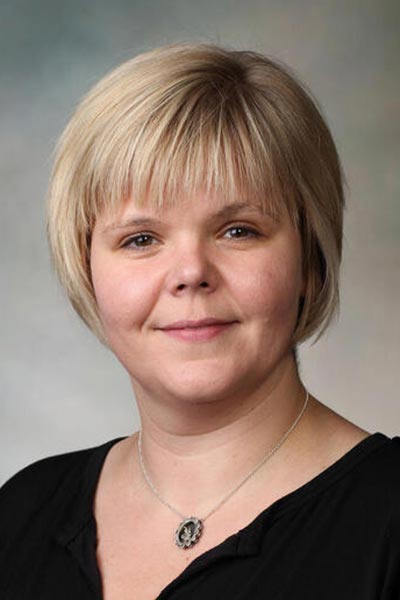Advances in quantitative sciences driving breakthroughs in cancer research
During an Annual Meeting symposium on Monday, April 17, three investigators discussed how they are leveraging computational and quantitative sciences to advance their cancer research at different levels of organization — from the atomic level to the molecular and organismal level.

The session, Advances in Quantitative Sciences in Cancer: From Atomic Scale to Patients, can be viewed on the virtual meeting platform by registered meeting participants through July 19, 2023.
Symposium chair Nagarajan Vaidehi, PhD, discussed her lab’s work using computational methods to study allostery and disordered proteins with the goal of designing next-generation targeted therapeutics.
Kinases represent a big target group in cancer therapeutics, but the current drugs in the clinic all target ATP-binding sites, which contain amino acids that are highly conserved across the kinome, and this leads to off-target effects, explained Vaidehi, Professor and Chair of the Department of Computational & Quantitative Medicine and Associate Director for Informatics and Computational Biomedicine at the Comprehensive Cancer Center at City of Hope.
Studies suggest that allosteric drugs may cause fewer off-target effects by extending beyond the ATP-binding site and targeting alternative binding sites that are less conserved, she continued. Developing these drugs involves a lot of “trial and error,” she said, so her lab and others are working to develop computational methods that can robustly identify allosteric sites that affect the function of the target protein.
Allosteric drugs are not totally new — there are known allosteric inhibitors for kinases — but they are not yet at the clinical level in cancer, Vaidehi said. “I think allosteric drugs are the way to go for the next generation of cleaner, cancer-targeted therapeutics.”

Peter Kuhn, PhD, the Dean’s Professor of Biological Sciences at the USC Keck School of Medicine and Michelson Center for Convergent Bioscience, discussed the potential utility of liquid biopsy as a complement to mammography in early detection and cell-level staging of breast cancer.
Of the nearly 300,000 cases of breast cancer occurring annually in the U.S., only about 50 percent are diagnosed via screening mammography. The overall accuracy of mammography is still quite limited at about 85 percent, and in women under 50 and those with dense breasts, the performance is even lower, he said. “That triggers a bunch of really complicated issues around how we actually screen younger women and how we improve on mammography.”
Kuhn and his colleagues developed a next-generation liquid biopsy platform based on multi-analyte analysis and tested this approach for early detection and stage-stratification in patients with early-stage and metastatic breast cancer and age- and gender-matched controls. As expected, they detected a higher level of circulating tumor cells in patients with late-stage disease compared to those with early-stage cancer and with normal donors. Interestingly, oncosomes, or large extracellular vesicles shed by cancer cells, were very abundant in early-stage patients and present in low amounts in late-stage patients and normal donors.
Comprehensive analysis of cellular and acellular components of the liquid biopsy allowed the researchers to build a test that yielded a very high accuracy for both breast cancer detection and stage differentiation.
With this next-generation liquid biopsy in breast cancer, we can reach a target population, achieve high accuracy, and complement the diagnostic workup as well, which is really important, Kuhn said.

Kristin R. Swanson, PhD, Professor and Vice Chair of Research in Neurosurgery and Director of the Mathematical Neuro-Oncology Lab at Mayo Clinic, explored the growing field of mathematical neuro-oncology, including her research attempting to elucidate the heterogeneity in glioblastoma biology, which exists across patients and across different regions of the same tumor.
Magnetic resonance imaging (MRI) only reveals portions of the tumor, Swanson explained. Her lab developed mathematical models to predict diffusion of tumor cells from a patient’s MRI. Furthermore, they collect image-localized mini biopsies at different locations throughout the tumor to gather histology, genomics, and transcriptomics information.
Overlaying imaging and the data obtained through these image-localized biopsies allows the researchers to build mechanistic models to predict disease evolution and response to therapy, and can inform the design of clinical trials, Swanson said.
One of the aspects of heterogeneity across patients is represented by sex differences, with males and females displaying different molecular signatures that drive the differences in outcomes, Swanson noted. The imaging patterns and the correlation between imaging and biology are also different between sexes, she added. Therefore, the models need to be trained to account for these sex-specific differences in order to obtain optimal accuracy.
Follow Along with the AACR Annual Meeting 2025
Keep up with the latest from the AACR Annual Meeting 2025, whether you are attending in person or virtually. Join the conversation on social media using the hashtag #AACR25 and read more coverage of upcoming sessions in AACR Annual Meeting News.

